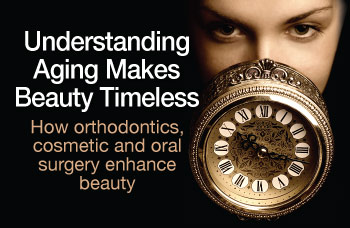Understanding Aging Makes Beauty Timeless
How orthodontics, cosmetic and oral surgery enhance beauty

Having an understanding of growth, development, and the aging process is fundamentally important to obtaining the optimal results from facial and cosmetic dental treatment. For years, researchers have been cataloguing the inevitable facial changes that occur over time, and the potential impact they can and do have on treatment decisions. The influence of these factors on orthodontics (“ortho” – to straighten; “odont” – tooth) has been quite significant. Thus, the focus has shifted from treatment that is based solely on changing the biting relationships of teeth to recognizing the importance of how teeth provide support to the soft tissues (lips, cheeks, tongue), define a smile, and contribute to the overall appearance of the face.
The Only Constant In Life Is Change
The idea that orthodontics and facial aesthetics should be considered concurrently is not new, but has recently received increasing attention. The relationship of the soft tissues of the face to the underlying bony skeleton is fast becoming the primary determinant of treatment. Growth of the face is enormously fascinating and complex involving the skeleton, jaws (dental arches), teeth, and facial or soft tissue growth — with genetic and environmental factors both playing significant roles in final facial form. With a welcome emphasis on these inter-related concepts, the specialties of dentistry can work together to produce beneficial and enhanced, overall, long-term treatment results.
New Meaning To “We Grow A Little Every Day”
Because most people stop getting taller in their late teens, researchers traditionally assumed growth ceased at that age. Remarkably, recent studies have revealed that change is ongoing throughout life. In fact, the amount of change in both skeletal and facial structures that occurs between ages 25 and 42 is very similar to the amount that occurs between ages 18 and 25. These realities have shed new light upon when orthodontic treatment and normal movement of the teeth is truly complete, and begins to explain many issues that can affect the stability of treatment results.




